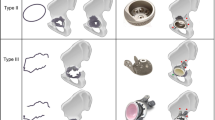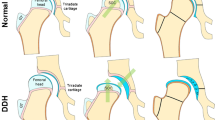Abstract
Purpose
This paper presents and validates a computer-navigated system for performing periacetabular osteotomy (PAO) to treat developmental dysplasia of the hip. The main motivation of the biomechanical guidance system (BGS) is to plan and track the osteotomy fragment in real time during PAO while simplifying the procedure for less-experienced surgeons. The BGS aims at developing a platform for comparing biomechanical states of the joint with the current gold standard geometric assessment of anatomical angles. The purpose of this study was to (1) determine the accuracy with which the BGS tracks the hip joint through repositioning and (2) identify improvements to the workflow.
Methods
Nineteen cadaveric validation studies quantified system accuracy, verified system application, and helped to refine surgical protocol. In two surgeries, navigation and registration accuracy were computed by affixing fiducials to two cadavers prior to surgery. All scenarios compared anatomical angle measurements and joint positioning as measured intraoperatively to postoperatively.
Results
In the two cases with fiducials, computed fragment transformations deviated from measured fiducial transformations by 1.4 and 1.8 mm in translation and \(1.0^{\circ }\) and \(2.2^{\circ }\) in rotation, respectively. The additional seventeen surgeries showed strong agreement between intraoperative and postoperative anatomical angles, helped to refine the surgical protocol, and demonstrated system robustness.
Conclusion
Estimated accuracy with BGS appeared acceptable for future surgical applications. Several major system requirements were identified and addressed, improving the BGS and making it feasible for clinical studies.






Similar content being viewed by others
References
Ganz R, Klaue K, Vinh TS, Mast JW (1988) A new periacetabular osteotomy for the treatment of hip dysplasias. Technique and preliminary results. Clin Orthop Relat Res 232:26–36
Hussell JG, Rodriguez JA, Ganz R (1999) Technical complications of the Bernese periacetabular osteotomy. Clin Orthop Relat Res 363: 81–92
Cooperman DR, Wallensten R, Stulberg SD (1983) Acetabular dysplasia in the adult. Clin Orthop Relat Res 175:79–85
Troelsen A (2009) Surgical advances in periacetabular osteotomy for treatment of hip dysplasia in adults. Acta Orthop Suppl 80:1–33
Albers CE, Steppacher SD, Ganz R, Tannast M, Siebenrock KA (2013) Impingement adversely affects 10-year survivorship after periacetabular osteotomy for DDH. Clin Orthop Relat Res 471:1602–1614
Troelsen A, Elmengaard B, Søballe K (2009) Medium-term outcome of periacetabular osteotomy and predictors of conversion to total hip replacement. J Bone Joint Surg Am 91:2169–2179
Langlotz F, Bachler R, Berlemann U, Nolte LP, Ganz R (1998) Computer assistance for pelvic osteotomies. Clin Orthop Relat Res 354: 92–102
Langlotz F, Stucki M, Bachler R, Scheer C, Ganz R, Berlemann U et al (1997) The first twelve cases of computer assisted periacetabular osteotomy. Comput Aided Surg 2:317–326
Armand M, Lepistö J, Tallroth K, Elias J, Chao E (2005) Outcome of periacetabular osteotomy: joint contact pressure calculation using standing AP radiographs, 12 patients followed for average 2 years. Acta Orthop 76:303–313
Armiger RS, Armand M, Tallroth K, Lepistö J, Mears SC (2009) Three-dimensional mechanical evaluation of joint contact pressure in 12 periacetabular osteotomy patients with 10-year follow-up. Acta Orthop 80:155–161
Hipp JA, Sugano N, Millis MB, Murphy SB (1999) Planning acetabular redirection osteotomies based on joint contact pressures. Clin Orthop Relat Res 364: 134–143
Tsumura H, Kaku N, Ikeda S, Torisu T (2005) A computer simulation of rotational acetabular osteotomy for dysplastic hip joint: does the optimal transposition of the acetabular fragment exist? J Orthop Sci 10:145–151
Armiger RS (2006) Development of a surgical guidance system for real-time biomechanical feedback during periacetabular osteotomy (Master’s thesis). Master’s thesis, Johns Hopkins University, Baltimore, MD
Lepistö J, Armand M, Armiger RS (2008) Periacetabular osteotomy in adult hip dysplasia—developing a computer aided real-time biomechanical guiding system (BGS). Suom Ortoped Traumatol 31:186–190
Armiger RS, Armand M, Lepistö J, Minhas D, Tallroth K, Mears SC et al (2007) Evaluation of a computerized measurement technique for joint alignment before and during periacetabular osteotomy. Comput Aided Surg 12:215–224
An KN, Himeno S, Tsumura H, Kawai T, Chao EY (1990) Pressure distribution on articular surfaces: application to joint stability evaluation. J Biomech 23:1013–1020
Genda E, Konishi N, Hasegawa Y, Miura T (1995) A computer simulation study of normal and abnormal hip joint contact pressure. Arch Orthop Trauma Surg 114:202–206
Volokh K, Chao E, Armand M (2007) On foundations of discrete element analysis of contact in diarthrodial joints. Mol Cell Biomech 4:67–73
Armand M, Merkle A, Sukal T, Kleinberger M (2002) Experimental evaluation of a model of contact pressure distribution in the hip joint. In: Proceedings of world congress on biomechanics, Calgary, Alberta
Elias J, Wilson D, Adamson R, Cosgarea A (2004) Evaluation of a computational model used to predict the patellofemoral contact pressure distribution. J Biomech 37:295–302
Michaeli DA, Murphy SB, Hipp JA (1997) Comparison of predicted and measured contact pressures in normal and dysplastic hips. Med Eng Phys 19:180–186
Schuind F, Cooney W, Linscheid R, An K, Chao E (1995) Force and pressure transmission through the normal wrist. J Biomech 28:587–601
Murphy SB, Kijewski PK, Millis MB, Harless A (1990) Acetabular dysplasia in the adolescent and young adult. Clin Orthop Relat Res 214–223
Tallroth K (2006) Developmental dysplasia of the Hip 2: adult. In: Davies AM, Johnson KJ, Whitehouse RW (eds) Imaging of the hip and bony pelvis: techniques and applications, medical radiology. Springer, Berlin, pp 125–140
Lepistö J, Tallroth K, Alho A (1998) Three-dimensional measures of acetabulum in periacetabular osteotomy. In: Orthopaedic research society 44th annual meeting
Anda S, Terjesen T, Kvistad KA (1991) Computed tomography measurements of the acetabulum in adult dysplastic hips: which level is appropriate? Skeletal Radiol 20:267–271
Anda S, Terjesen T, Kvistad KA, Svenningsen S (1991) Acetabular angles and femoral anteversion in dysplastic hips in adults: CT investigation. J Comput Assist Tomogr 15:115–120
Wiberg G (1939) Studies on dysplastic acetabula and congenital subluxation of the hip joint with special reference to the complications of osteoarthritis. Acta Chir Scand 83:53–68
Tönnis D (1987) Congenital dysplasia and dislocation of the hip in children and adults. Springer, Berlin
Besl PJ, McKay ND (1992) A method for registration of 3-d shapes. IEEE Trans Pattern Anal Mach Intell 14:239–256
Moghari MH, Abolmaesumi P (2005) A novel incremental technique for ultrasound to CT bone surface registration using unscented Kalman filtering. Med Image Comput Comput Assist Interv 8:197–204
Sadowsky O, Cohen JD, Taylor RH (2005) Rendering tetrahedral meshes with higher-order attenuation functions for digitial radiograph reconstruction. In: Visualization conference, IEEE p 39
Sadowsky O, Cohen JD, Taylor RH (2006) Projected tetrahedra revisited: a barycentric formulation applied to digitial radiograph reocnsturation using higher-order attenuation functions. IEEE Trans Vis Comput Graph 12:461–473
Chintalapani G, Murphy R, Armiger R, Lepisto J, Otake Y, Sugano N, et al (2010) Statistical atlas based extrapolation of CT data. In: SPIE medical imaging, international society for optics and photonics, p 762539
Kutty S, Schneider P, Faris P, Kiefer G, Firzzel B, Park R, Powell JN (2012) Reliability and predicatability of the centre-edge angle in the assessment of pincer femoroacetabular impingement. Int Orthop 36(3):505–510
Acknowledgments
The authors thank Dr. Stephen Belkoff for the use of his cadaver lab, and Mr. Demetries Boston for his assistance during cadaveric testing. This work was funded through Grant R01EB006839-01 National Institute of Biomedical Imaging and Bioengineering (NIBIB) of the National Institutes of Health (NIH), and internal funds from the Johns Hopkins University.
Author information
Authors and Affiliations
Corresponding author
Rights and permissions
About this article
Cite this article
Murphy, R.J., Armiger, R.S., Lepistö, J. et al. Development of a biomechanical guidance system for periacetabular osteotomy. Int J CARS 10, 497–508 (2015). https://doi.org/10.1007/s11548-014-1116-7
Received:
Accepted:
Published:
Issue Date:
DOI: https://doi.org/10.1007/s11548-014-1116-7




